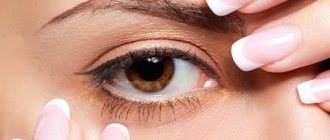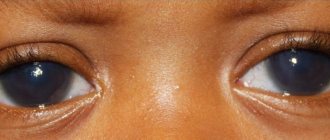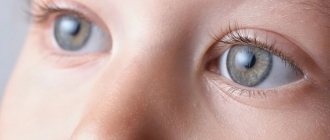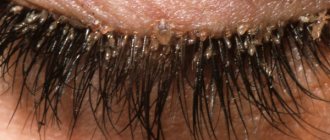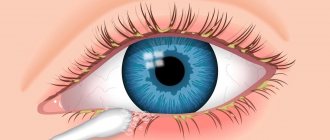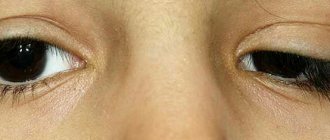Symptoms of glaucoma appear when more than half of the nerve fibers of the optic nerve have died, before which a person can live in complete harmony with increased intraocular pressure, without any unpleasant symptoms. When signs of impairment become persistent, lost vision cannot be restored, but the progression of the disease can be stopped.
Our expert in this field:
Vasinkina Inna Yurievna
Neurologist
Call the doctor
Symptoms of glaucoma development
In the initial stages of the development of glaucoma in a person, only one symptom is detected - increased intraocular pressure or ophthalmotonus, which does not affect visual acuity in any way.
Since the nerve is able to functionally compensate for the loss of part of its fibers for a very long time, the patient does not notice the development of the disease. The real beginning of glaucomatous degeneration is almost impossible to determine. Of course, an ophthalmological examination will reveal damage to the optic disc, but the patient does not feel this at all. On the one hand, it is good that there are no unpleasant symptoms of the disease, but when there are no obvious signs of pathology, a person does not go to an ophthalmologist, and without treatment, irreversible changes occur.
Prevention and prognosis
Glaucoma is one of those diseases that develops faster in the presence of favorable factors, but can occur even in a healthy person. Risk factors include bad habits, especially smoking, because tars have an extremely negative effect on all structures of the eye. The risk of glaucoma increases in people with hypertension and diabetes. Working with your head down for a long time can contribute to the development of the disease.
It is important to periodically visit an ophthalmologist and measure intraocular pressure once a year. People who are at risk need to undergo tonometry twice a year.
Risk group for acute-angle glaucoma:
- older and elderly people (dystrophy of eye structures, thickening of the lens);
- women;
- Asians (features of eyelid anatomy);
- people with farsightedness;
- people with circulatory disorders.
With timely treatment, glaucoma can be controlled, but in most cases the prognosis remains average. It all depends on the characteristics of the disease in a particular patient and the rate of its progression.
For 65 million people with elevated intraocular pressure, 7 million are permanently blind. The insidiousness of the disease lies in the fact that even with regular examinations it is very difficult to detect it at the initial stage. It is important to pay attention to every symptom, even the most minor one.
Sources used:
- Kvasova M. D. Vision and heredity. - Moscow / St. Petersburg: Dilya, 2002.
- Modern ophthalmology. Management. - M.: Book on Demand, 2009.
- Introduction to clinical ophthalmology / E.E. Somov. - M.: Leningrad Pediatric Medical Institute, 1993.
- IU School of Medicine Department of Ophthalmology
Typical symptoms of glaucoma
The first symptoms are loss of visual fields, when part of it disappears when looking at an object. There is a narrowing of the boundaries of lateral vision, as if a large hood with a visor is put on the head and the person sees only what is in front, but nothing to the side. But the loss of “pieces” of the review may not affect vigilance in any way, and no attention is paid to the limited review.
Sometimes patients notice the appearance of rainbow circles when looking at the light. In most cases, a person goes to an ophthalmologist when his vision deteriorates, and the flickering of flies, a decrease in the field of view, especially rainbows before the eyes, are not alarming.
Doctors' opinion
Doctors believe that an integrated approach takes place if the patient has no contraindications to the use of certain drugs. At the same time, you should not limit yourself to medications and folk remedies, because other factors are also important in glaucoma:
- proper nutrition;
- special exercises for the eyes;
- consumption of vitamin complexes;
- reducing eye strain;
- regular examination by an ophthalmologist.
With an integrated approach, it will be possible to slow down the progression of the disease, relieve pain and discomfort in the eyes and avoid possible surgery or laser surgery.
Important! Folk remedies can be used after consultation with a doctor, but they cannot replace prescribed medications.
Course of an acute attack of glaucoma
With angle-closure glaucoma, when the absorption of aqueous humor is impaired, acute attacks can occur, then the symptoms of the disease can no longer be ignored.
As a rule, suddenly a veil appears before the eye for no reason, a sharp deterioration in vision is possible, all accompanied by bursting acute pain in the eye. The pain is very intense and radiates to the temple, as with trigeminal neuralgia. It hurts to look at the light; rainbow circles begin to dance before your eyes. There may be nausea and vomiting.
The attack does not always begin acutely, in some cases the symptoms are smoothed out, the patient notices only rainbow flashes and a slight decrease in vision, however, this is also a dangerous manifestation that leads to loss of visual acuity.
At the time of the attack, it is necessary to urgently consult an ophthalmologist, since the condition threatens irreversible and rapid loss of vision due to severe ischemia of the optic nerve.
Diagnosis of glaucoma
Intraocular pressure is measured in two ways: with the help of weights - a legacy of past years, and with a special apparatus with an air stream directed into the eye.
It is mandatory to examine the angle of the anterior chamber - gonioscopy; all membranes of the eye and the fundus of the eye are examined, where the condition of the fibers of the optic nerve head is clearly visible. With computer diagnostics, visual fields are determined with micron precision and completely painlessly for the patient.
For timely detection of the disease, a certain frequency of examinations by an ophthalmologist has been established; computer diagnostics makes it possible to identify the very initial changes. This is also important because in half of the cases, intraocular pressure does not exceed normal values, but the disease develops; the ophthalmologist at Clinic Medicine 24/7 will identify minimal signs and prescribe treatment. Sign up for diagnostics: +7 (495) 230-00-01
The cause of glaucoma is an increase in pressure in the eye due to excess production or poor outflow of aqueous humor, which washes all the internal structures of the eye, bringing them nutrition and taking away everything unnecessary. A variant of the disease that develops with normal intraocular pressure has been identified - normotensive, combined with diseases of the microvascular bed in the head.
Take care of yourself, book a consultation now
Alternative medicine before and after surgery
If conservative therapy does not lead to a positive result, more radical measures are used. For glaucoma, laser or surgical surgery is recommended, and during the rehabilitation period, folk remedies can be used to speed up healing. Before doing this, you should definitely consult your doctor to avoid complications.
Rules for the use of folk recipes in the postoperative period:
- in the first few days after surgery, it is necessary to reduce fluid intake to 1.5 liters per day to avoid swelling;
- it is necessary to adjust the diet and exclude fried, fatty, smoked and spicy foods from the diet;
- Smoking and drinking alcohol are prohibited;
- minimize eye strain.
After the operation, the patient is prescribed non-steroidal anti-inflammatory drops, as well as antibiotics. Traditional medicine can be used as an auxiliary method that will help you recover faster, get rid of swelling, pain and discomfort.
Expert opinion
Kim Oksana Alexandrovna
Head of the ophthalmology clinic. Ophthalmologist with more than 10 years of experience.
During rehabilitation, it is recommended to use folk remedies only for oral administration, so as not to irritate the eyes that have recently been subject to intervention. In addition, lotions and compresses can cause infection, because a moist and warm environment is ideal for the growth of bacteria.
Several weeks or even months after surgery, you can consult your doctor to find out if you can use lotions, compresses, and eye drops made at home.
The most common cause of glaucoma
The internal fluid is aqueous humor, it is not a tear, but almost plasma filtered from the blood, but less saturated with proteins. Aqueous humor makes the eye elastic, preventing the cornea from sticking to the iris; normally, it is produced as much as it is absorbed, that is, an absolute balance. Ciliary cells synthesize moisture, and it is absorbed in the inner corner of the eye formed by the iris and cornea, which is called the anterior chamber angle.
The cause of glaucoma is an imbalance, either the production of moisture by the ciliary cells increases, or its absorption in the angle decreases. Constantly high pressure in the eye compresses the retina, which causes ischemia resulting in optic nerve atrophy, and is manifested by loss of vision, first in the periphery, and then the visual field narrows to the size of the eyepiece of a telescope. High blood pressure as a cause of glaucoma is detected in only half of patients.
The most effective recipes
Judging by the reviews, the most effective traditional medicine in the fight against glaucoma are honey compresses, washing the eyes with herbal decoctions and using herbal preparations internally.
You can make a more complex recipe with honey:
- hard boil a chicken egg, cut in half, remove the yolks;
- pour honey into the holes in the whites and connect the two halves;
- place the egg in the oven for 30 minutes;
- Pour the honey mixture into a sterile container and cool;
- instill 1 drop of the product into each eye 1 time per day according to the scheme: instill 2 days, 2 days off.
Blueberries are known for their healing properties, which protect the blood vessels of the eyes and reduce intraocular pressure. The berry can be consumed in any form, but it is better to eat 150-200 g of fresh berries daily.
Drinking rosehip decoction has a positive effect not only on the condition of the eyes, but also on the entire body. The decoction can be consumed daily at any time, 1 glass. Doctors recommend not to exceed the norm of 1 liter of decoction per day.
Many people with glaucoma recommend drinking a glass of tomato juice daily with a teaspoon of honey diluted in it. It is better if it is natural juice rather than packaged juice.
A useful vitamin cocktail for glaucoma is made by mixing fresh juices of celery, parsley, carrots, beets and cucumber. This cocktail contains all the vitamins and microelements necessary for the normal functioning of the eye apparatus.
Genetic aspects of glaucoma
Congenital glaucoma is not necessarily hereditary; a possible cause is considered to be underdevelopment of the eye due to the prematurity of the baby. There are fetal developmental anomalies, the complex of symptoms of which includes congenital glaucoma.
Mutations have been traced that cause familial inheritance of the disease when the production of moisture by ciliary cells is disrupted - the open-angle form of the disease. In addition, Africans suffer from the disease much more often than other peoples, which confirms the role of genetics in the development of the process.
Normal pressure glaucoma is attributed to gene activity and such mutations have already been identified. Close relatives of a sick woman are three times more likely to develop the disease.
But genetics alone cannot explain the reasons for such a frequent development of the disease after 80 years of life, when it is found in every sixth person.
Anatomical causes of glaucoma
Women are three times more likely to be affected by the disease, which is caused by inadequate absorption of moisture due to the smaller size of the anterior chamber of the eye - this is a closed-angle variant of the disease.
The small volume of the chamber leads to a high incidence of the disease in peoples with a narrow eye shape; northern people are especially often affected.
In some nearsighted young people, the iris is not convex, but concave; when looking at objects, the lens touches it, scraping off the pigment. The pigment clogs drainage channels, just as leaves block sidewalk drainage grates, and blocks the flow of moisture, causing disease.
What processes can disrupt eye pressure?
The disease is caused by long-term use of corticosteroids or impaired microcirculation in the eye as a result of diabetes mellitus or narrowing of the retinal veins. This will be a secondary disease when the pathological process in the eye is initiated by another disease, tumor or injury, and is inherently a complication of another disease or condition.
Trauma and inflammation of the eye can change the relationship of internal structures and, due to scars, disrupt the outflow of aqueous humor, reducing the size of the anterior chamber angle. Similar troubles are caused by cataracts, which swell and block the flow of moisture through the pupil into the anterior chamber, or injury to the lens with its dislocation, when it closes the pupil like a valve.
Glaucoma is not one disease, but a whole group of diseases with its own causes and mechanism of development, therefore treatment and prognosis for vision preservation are strictly individual. In each case, it is necessary to find what became the trigger so that the effect of therapy is good and lasting. At the Medicine Clinic 24/7, diagnostic capabilities allow you to understand each case of the disease. Sign up for a consultation
Glaucoma is a group of diseases with constant or occasional increased pressure inside the eye, which is caused by excess production or impaired outflow of aqueous humor. An imbalance of fluid with compression of the retina leads to atrophy of the optic nerve and the formation of a tube visual field.
We will call you back
leave your phone number
Healing herbs for glaucoma
Healing herbs for glaucoma are used to create tinctures, decoctions, lotions, compresses and eye drops. They act gently, penetrate into the deep structures of the eye, and have virtually no contraindications or side effects.
woodlouse
Woodlice is a grass that gardeners consider a weed and try in every possible way to get rid of it. However, it is a good assistant in the treatment of glaucoma.
A tincture for oral administration is prepared from the herb according to the following recipe:
- Wash the bunch of grass well and let it dry.
- Grind through a food processor or meat grinder, strain.
- Mix fresh wet juice with alcohol in a ratio of 0.5 cups of alcohol per 1 liter of juice and put in the refrigerator.
It is recommended to take the tincture before meals in the amount of 2 tbsp. 1 per day.
Aloe
Aloe, known for its healing properties, is used to wash the eyes for glaucoma. A clean leaf of the plant must be thoroughly washed, crushed and poured with a glass of boiling water.
After 3 hours, the product should be filtered several times and used to wash the eyes up to 3 times a day.
Duckweed
Duckweed is an aquatic plant that can be found in a pond or lake. It contains protein, fiber, iodine, bromine and other useful microelements.
In the fight against glaucoma, it is used in the form of a lotion, alcohol infusion or regular tincture. The plant must be collected, washed well, chopped and dried in sufficient quantity. To get the tincture, you need 2 tbsp. raw materials pour 500 ml of boiling water, cool, strain and use for eye wash, lotions or 1 tbsp orally. a day before meals.
Nettle
A tincture is obtained from nettle in the following way: the young herb is washed well and cut into small pieces. 2 tbsp. of raw materials, pour 250 ml of boiling water, leave for an hour and take a third of a glass 3 times a day.
Motherwort
For glaucoma, motherwort infusion is effective: 1 tbsp. dry crushed herb, pour a glass of boiling water, leave for an hour, strain and take 1 tbsp. 3 times a day.
The course of treatment (30 days) can be repeated every 10 days off.
Flax-seed
Flaxseed, which is used to treat and prevent many diseases, will also help with glaucoma. The maximum result can be achieved by mixing in equal proportions birch leaves, lingonberry leaves, string, plantain, nettle, horsetail, St. John's wort, rose hips and flaxseed.
The resulting mixture should be poured with boiling water and left to infuse overnight. In the morning, strain the infusion and take 1 tbsp. 3 times a day for a month.
Who gets glaucoma?
Glaucoma is the scourge of the elderly population of the planet; in the fifth decade of a person’s life, the disease affects one out of every thousand, in the seventh - three out of a hundred peers, and after 80 years - every sixth. Congenital glaucoma is uncommon: one in 12.5 thousand newborns, predominantly affecting boys, and in two out of three both eyes are affected.
For four patients whose disease is associated with malabsorption, there is only one patient with moisture hypersynthesis. Excess moisture production is typical for men, but they begin to get sick a decade earlier than women. In a variant of the disease when the absorption of excess aqueous humor is impaired, there are three women “after 50” for every sick man.
Pigmentary glaucoma affects young myopic men; they have a deformed iris, from which the lens, during its natural movements - accommodation, scrapes off the pigment that clogs the drainage channels.
Why is glaucoma dangerous?
Compressed by excess fluid, the sensitive cells of the retina, which are a continuation of the fibers of the optic nerve, experience a lack of blood supply - ischemia and gradually die, which is manifested by loss of peripheral vision. At first, small areas fall out of view, then the field of view is limited, and then it becomes tubelike, as if you are looking through a telescope - you can only see in front, and it’s dark on the sides. As the process of nerve damage progresses, vision is completely lost.
Conservative treatment of glaucoma
The most important thing in the treatment of glaucoma is compliance with the medication regimen prescribed by the doctor; in most cases, reducing intraocular pressure requires instillation of drops, which cause extremely unpleasant sensations. When the disease has not yet manifested itself as visual disturbances, and only an increase in intraocular pressure has been established, it is very difficult to force yourself to have eye drops on a regular schedule. Medicines have a limited duration of action and are quickly eliminated by the drainage system of the eye.
There are enough medicines today, but there are no cures, but they can stop the progression of the pathology. Drops are selected according to the type of glaucoma and stage, the goal is to reduce intraocular pressure to a normal level or at least a third of the original figure. It is better to do this with a smaller number of drugs, so as not to spoil the quality of life with frequent infusions of drops.
The effectiveness of home treatment
Traditional methods and adherence to recommendations are effective at the initial stage of glaucoma and in the complex treatment of advanced forms. The following must be observed:
- drinking regimen - no more than 3 liters per day, preferably in small quantities at a time to prevent increased IOP and edema;
- avoid high temperatures, do not visit baths and saunas;
- minimize strong physical activity, heavy sports;
- do not tilt your head forward for a long time, avoid washing by hand in this position, washing floors, etc.;
- food should be as healthy as possible, exclude alcoholic beverages, salty, fatty and fried foods.
Compliance with home treatment methods allows you to delay complications of the disease, in particular visual impairment and blindness.


